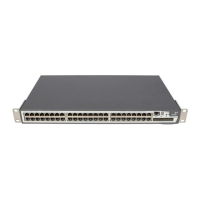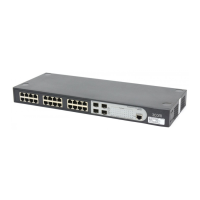QoS Configuration Commands List 303
undo traffic-priority inbound { ip-group
acl-number
[ rule
rule
[
link-group
acl-number
rule
rule
] ] | link-group
acl-number
[ rule
rule
] }
View
Ethernet Port View
Parameter
inbound: Performs priority marking to the packets received by the interface.
ip-group
acl-number
: Activates IP ACLs, including basic and advanced ACLs.
acl-number
: Sequence number of ACL, ranging from 2000 to 3999.
link-group
acl-number
: Activates Layer 2 ACLs.
acl-number
: Sequence number
of ACL, ranging from 4000 to 4999.
rule
rule
: Specifies the subitem of an active ACL, ranging from 0 to 65534; if not
specified, all subitems of the ACL will be activated. If only an IP ACL or a Layer 2
ACL is activated, this parameter can be omitted. If both IP and Layer 2 ACLs are
activated at the same time, the
rule
parameter cannot be omitted.
dscp
dscp-value
: Set DSCP priority, ranging from 0 to 63.
ip-precedence {
pre-value
| from-cos }: Set IP precedence, pre-value ranges
from 0 to 7.
from-cos means to set the IP precedence with the corresponding
802.1p priority value.
cos {
pre-value
| from-ipprec }: Set 802.1p priority. pre-value ranges from 0
to 7.
from-ipprec means to set the 802.1p priority of the packet with the
corresponding 802.1p priority value.
local-precedence: This does not actually remark the packet but gives it an
internal "local-precedence" that determines which queue it is assigned to. The
queue can be determined by looking at cos-local precedence map using the
display qos cos-local-precedence command.
Description
Use the traffic-priority command to activate an ACL and perform priority
marking.
Use the undo traffic-priority command to remove the priority marking.
The system can mark the packets with various levels DSCP priority, IP Precedence,
CoS (802.1p) priority and local Precedence.
Related command: display qos-interfacee traffic-priority.
Example
Perform priority marking to packets that match with the permit rule of ACL 2000.
Set its 802.1p priority to 0.
<SW5500>system-view
System View: return to User View with Ctrl+Z

